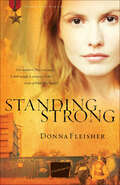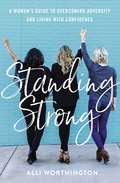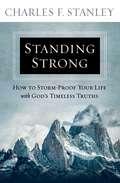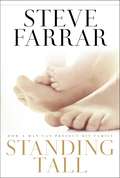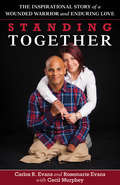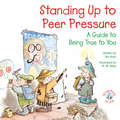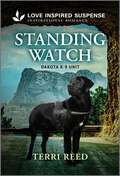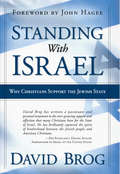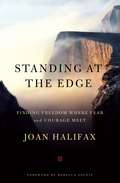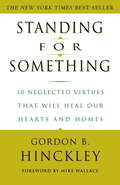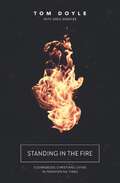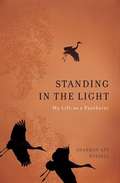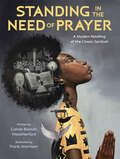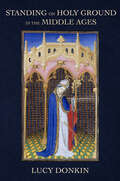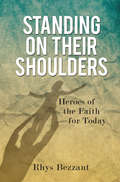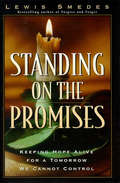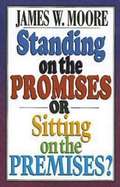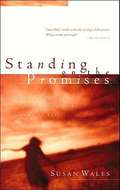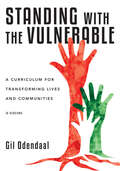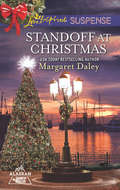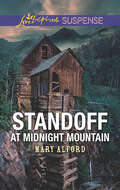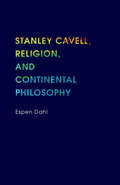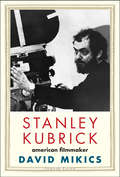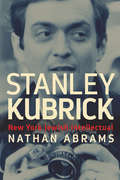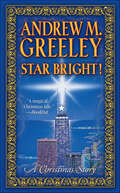- Table View
- List View
Standing Strong (Homeland Heroes #4)
by Donna FleisherChris McIntyre has found a home at last. And life is good, with Chris savoring her status as a new aunt while she and Jason continue to explore their evolving relationship. But it&’s going to take a hero&’s heart to defend the community she treasures. It&’s the sweltering summer of 1996, and the quiet life of Kimberley Square is shattered by the sound of screeching tires as rival gangs battle to claim the neighborhood that has become home to Chris. This new kind of turf war between gangs is far more frightening than anything she and her buddies encountered on the battlefields of Desert Storm. Even as she guards her home, Chris also wonders if she dares to let down her guard emotionally. Will she have to choose between her love for Christ and her growing love for Jason? Standing Strong is the fourth novel in the Homeland Heroes series by Donna Fleisher
Standing Strong: A Woman's Guide to Overcoming Adversity and Living with Confidence
by Alli WorthingtonYou can't break a woman who draws her strength from God. God made you to stand strong in any adversity, and this book will show you how. We live in a culture that constantly tells you who you should be as a woman. You are told that you are not enough and that you don't have what it takes--you are asked, "Who are you to dream big?"For the woman who longs to break free from what holds her back, bestselling author Alli Worthington offers a no-nonsense, guilt-free guide to take back your life from self-doubt.In Standing Strong, Alli comes alongside as your guide as you:Eliminate, once and for all, the lies that keep you from being who God made you to beBecome an unbreakable woman who finds her strength from God for any adversityGain strategies for tackling the obstacles of self-doubt, fear, and insecurityFind the confidence to say yes and amen to God's call on your lifeYou are stronger than you think, and you are worth more than you could ever imagine. So let go of the guilt, shake off the shame, and fend off your fears as you fight with your faith. It's time to remember who you are: a woman God has called to partner with him--to be a fierce force for good in the world to the glory of God.
Standing Strong: How to Storm-Proof Your Life with God's Timeless Truths
by Charles F. StanleyThis powerful book from Dr. Charles Stanley outlines key areas of conviction that can make or break who we are and how we live.What we choose to believe intrinsically determines whether or not we are able to stand strong in this life. Including our convictions about God and who he is, about the Bible, about prayer, and our own personal life convictions, Standing Strong provides help and instruction on examining and shaping what we believe so that we can live strong, with confidence and hope.
Standing Tall: How a Man Can Protect His Family
by Steve FarrarA leader must stand tall enough for his followers to find him. "As the God-appointed captain of his family," says Steve Farrar, "a man faces the challenge of spying out the social territory, marking danger zones, and taking stands to protect those in his charge." It's an active leadership role -- and Farrar's been training men to succeed in it for over ten years. In this paperback rerelease of his popular Standing Tall, the men's ministries leader "walks tall" through America -- observing politics, abortion, the gay movement, media trends, and the loss of our "moral boundaries." Farrar offers men sure biblical foundations on which to stand for faith-based living -- closing with "Seven Ways to Help Your Kids Stand Tall." A study guide/appendix makes it great for group use, too!From the Trade Paperback edition.
Standing Together: The Inspirational Story of a Wounded Warrior and Enduring Love
by Cecil Murphy Carlos R. Evans Rosemarie EvansA true story of hope and courage in the face of astonishing challengesDuring his fourth deployment, US Marine Corps Sergeant Carlos Evans stepped on an IED--and the loss of both legs and his left hand was just the beginning of the struggle for his life.For the next two years, he and his wife, Rosemarie, went through the rehabilitation process together. As a nurse and mother of two young children, Rosemarie was used to caring for people, but the task of taking care of her triple-amputee husband brought new challenges every day. In addition to his limb loss, Carlos faced PTSD and developed an addiction to painkillers. He was sure Rosemarie's life would be better without him--and that it might have been better if he hadn't survived at all.But unlike the majority of marriages put under similar strain, Carlos and Rosemarie stayed together. With the help of family, friends, and--most importantly—a strong faith, they've built a solid marriage and discovered a ministry they never expected. By the hand of God, their story, which began in devastation, has turned into one that draws in and lifts up more people than either of them would ever have dreamed.Not only will disabled veterans and their loved ones find help here, Carlos and Rosemarie's captivating journey also speaks to those who long for stronger marriages, care for loved ones with disabilities, or are facing a new normal in their own lives, small or large. It is a powerful resource for leaning on God in the midst of life's great difficulties--and for finding ways that, through faith, profound loss can bring incredible blessing.
Standing Up to Peer Pressure
by Jim Auer R. W. AlleyWanting to be accepted by peers is a natural part of children's social development. Yet kids can be overly influenced by what "friends" think of them or urge them to do. Through simple language and engaging illustrations, this book explains the concept of peer pressure. It encourages a solid sense of self-identity--or "elf-identity"--and teaches kids how to say "No."
Standing Watch (Dakota K-9 Unit)
by Terri ReedTo protect an innocent witness… a K-9 must sniff out a killer. When K-9 task force officer Zach Kelsey&’s estranged wife is attacked at a Mount Rushmore observation deck, he and his K-9, Amber, are quick to come to her rescue. He discovers not only that Eden, a park ranger, is carrying his child, but that she saw her coworker&’s murder. As the only witness to the crime, Eden has no choice but to accept Zach&’s protection. But with a ruthless killer ramping up his vicious attacks, they must put their differences aside to catch the murderer…before Eden becomes his next target.From Love Inspired Suspense: Courage. Danger. Faith.Dakota K-9 Unit Book 1: Chasing a Kidnapper by Laura ScottBook 2: Deadly Badlands Pursuit by Sharee StoverBook 3: Standing Watch by Terri ReedBook 4: Cold Case Peril by Maggie K. BlackBook 5: Tracing Killer Evidence by Jodie Bailey
Standing With Israel: Why Christians Support Israel
by David BrogFocusing on a subject that has been covered by various national media, including the Wall Street Journal, 60 Minutes, and Nightline, Standing With Israel goes beyond politics to: •Profile leading Christian Zionists and detail the views and motives that drive their politics. •Spotlight Jews who have been at the forefront of forming a budding alliance with Israel&’s Christian allies. •Explain why so many American Jews are deeply uncomfortable with this outpouring of Christian support.
Standing at the Edge: Finding Freedom Where Fear and Courage Meet
by Rebecca Solnit Joan Halifax"Joan Halifax is a clearheaded and fearless traveler and in this book…she offers us a map of how to travel courageously and fruitfully, for our own benefit and the benefit of all beings." —From the foreword by Rebecca Solnit Standing at the Edge is an evocative examination of how we can respond to suffering, live our fullest lives, and remain open to the full spectrum of our human experience.Joan Halifax has enriched thousands of lives around the world through her work as a humanitarian, a social activist, an anthropologist, and as a Buddhist teacher. Over many decades, she has also collaborated with neuroscientists, clinicians, and psychologists to understand how contemplative practice can be a vehicle for social transformation. Through her unusual background, she developed an understanding of how our greatest challenges can become the most valuable source of our wisdom—and how we can transform our experience of suffering into the power of compassion for the benefit of others.Halifax has identified five psychological territories she calls Edge States—altruism, empathy, integrity, respect, and engagement—that epitomize strength of character. Yet each of these states can also be the cause of personal and social suffering. In this way, these five psychological experiences form edges, and it is only when we stand at these edges that we become open to the full range of our human experience and discover who we really are. Recounting the experiences of caregivers, activists, humanitarians, politicians, parents, and teachers, incorporating the wisdom of Zen traditions and mindfulness practices, and rooted in Halifax's groundbreaking research on compassion, Standing at the Edge is destined to become a contemporary classic. A powerful guide on how to find the freedom we seek for others and ourselves, it is a book that will serve us all.
Standing for Something: 10 Neglected Virtues That Will Heal Our Hearts and Homes
by Gordon B. HinckleyIn this national bestseller, the president of The Church of Jesus Christ of Latter-day Saints, Gordon B. Hinckley, has created a classic look at the values that can change our world--and how to stand up for them. Drawing on anecdotes from his much-admired life of faith and service, as well as examples from American culture today, he examines ten virtues that have always illuminated the path to a better world: love, honesty, morality, civility, learning, forgiveness and mercy, thrift and industry, gratitude, optimism, and faith. He then shows how the two guardians of virtue--marriage and the family--can keep us on that path, even in difficult times. Standing for Somethingis an inspiring blueprint for what we all can do--as individuals, as a nation, and as a world community--to rediscover the values and virtues that have historically made us strong and that will lead us to a brighter future.
Standing in the Fire: Courageous Christians Living in Frightening Times
by Tom DoyleNot Even ISIS Can Scare Them Off Followers of Christ need to relearn what it means to stand courageously for their faith rather than merely survive in a climate of fear. Instead of motivating believers to action, today&’s headlines appear to be paralyzing them. Standing in the Fire demonstrates the church triumphant through the lives of people who stood strong and didn&’t run away in the face of overwhelming danger. These Middle Eastern heroes of faith fear God more than terrorist groups like ISIS. Supported by Tom Doyle&’s commentary on events, the stories included show how these Christians are not living as victims, but victors in Christ.
Standing in the Light: My Life as a Pantheist
by Sharman Apt RussellEverything is connected, and the web is holy. So wrote Marcus Aurelius, the starting point of Sharman Russell's wise and haunting new memoir about her life as a pantheist. Perhaps no other religious philosophy is as simple and inclusive as pantheism.
Standing in the Need of Prayer: A Modern Retelling of the Classic Spiritual
by Carole Boston Weatherford Frank MorrisonFrom an award-winning author and critically acclaimed artist comes a stunning and deeply moving picture book based on the popular spiritual. The classic lyrics have been reworked to chronicle the milestones, struggles, tragedies, and triumphs of African American history. <P><P>This inspirational book encapsulates African American history and invites conversations at all levels. Carole Boston Weatherfords’s riveting text and Frank Morrison’s evocative and detailed paintings are informative reminders of yesterday, hopeful images for today, and aspirational dreams of tomorrow. <p><p>Stretching more than four hundred years, this book features pivotal moments in history, such as the arrival of enslaved people in Jamestown, Virginia, in 1619; Nat Turner's rebellion; the integration of the US military; the Selma to Montgomery marches; and peaceful present-day protests. It also celebrates the feats of African American musicians and athletes, such as Duke Ellington and Florence Griffith Joyner. <p><p>Visually stunning and incredibly timely, this book reckons with a painful history while serving as a testament to the human spirit's ability to persevere in even the most hopeless of circumstances. Its universal message of faith, strength, and resilience will resonate with readers of all ages. <p><P>The end of the book includes descriptions of the people, places, and events featured, along with a note from the author. <P><P><i>Advisory: Bookshare has learned that this book offers only partial accessibility. We have kept it in the collection because it is useful for some of our members. Benetech is actively working on projects to improve accessibility issues such as these.</i>
Standing on Holy Ground in the Middle Ages
by Lucy DonkinStanding on Holy Ground in the Middle Ages illuminates how the floor surface shaped the ways in which people in medieval western Europe and beyond experienced sacred spaces.The ground beneath our feet plays a crucial, yet often overlooked, role in our relationship with the environments we inhabit and the spaces with which we interact. By focusing on this surface as a point of encounter, Lucy Donkin positions it within a series of vertically stacked layers—the earth itself, permanent and temporary floor coverings, and the bodies of the living above ground and the dead beneath—providing new perspectives on how sacred space was defined and decorated, including the veneration of holy footprints, consecration ceremonies, and the demarcation of certain places for particular activities.Using a wide array of visual and textual sources, Standing on Holy Ground in the Middle Ages also details ways in which interaction with this surface shaped people's identities, whether as individuals, office holders, or members of religious communities. Gestures such as trampling and prostration, the repeated employment of specific locations, and burial beneath particular people or actions used the surface to express likeness and difference. From pilgrimage sites in the Holy Land to cathedrals, abbeys, and local parish churches across the Latin West, Donkin frames the ground as a shared surface, both a feature of diverse, distant places and subject to a variety of uses over time—while also offering a model for understanding spatial relationships in other periods, regions, and contexts.
Standing on Their Shoulders: Heroes of the Faith for Today
by Rhys BezzantBeing a Christian means being part of a bigger story, for God has worked in the course of history to make a people for himself. There is great joy in being part of this story, because we are spared the anxiety of creating ourselves out of nothing. Rather than going it alone, we stand on the shoulders of those before us in the faith, and consequently see further.The studies in Heroes of the Faith tell the stories of twelve great heroes of the faith from the last two thousand years of history. Sometimes their strengths drove their story, sometimes their weaknesses, but their lives left others profoundly changed. From each of these flawed but faithful mentors, we can draw courage and receive spiritual nurture as we contend for the faith today.
Standing on the Promises
by Lewis SmedesIn this fearful and cynical age, when doom and gloomers forecast catastrophe and fear mongers try to get us to hedge our bets on the future with insurance policies and safety nets, we need to re-discover real hope. Lewis Smedes says, "Hope is as native to our spirits as thinking is to our brain. Keep hoping, you keep living. Stop hoping, you start dying". He shows how hope powers every good thing we accomplish and helps us overcome every bad thing we encounter. He talks about how to keep hope alive in difficult times, discern false hope from true hope, and move beyond worry to trust in God.
Standing on the Promises or Sitting on the Premises?
by James W. MooreAre you standing on the promises or just sitting on the premises? Do you claim and embrace and celebrate the great promises of God that are underscored again and again in the Bible? Or do you sit lifelessly and listlessly on the remote edges of the church, responding halfheartedly to its message?In this new edition of his inspiring book, James W. Moore awakens us with these questions and reminds us of the awesome promises of God that are found in the Bible. On page after page of the Scriptures, God gives us generous and gracious promises that we can claim and rely on. The author shows that when we fail to lean on God and trust in these promises, we open ourselves to many frustrating, embarrassing, even painful experiences. Yet when we truly “stand on the promises,” we discover the richness and fullness that God intended for our lives.This new edition of the book includes a study guide.
Standing on the Promises: A Woman’s Guide for Surviving the Storms of Life
by Susan Wales Holly HalversonWhen trying seasons come -- as they often do -- women seek firm ground on which to stand. Author Susan Wales shares wisely from a lifetime of personal experience and communication with other women who have coped with the sometimes-piercing hurts within marriage, motherhood, infertility, divorce, financial loss, career, family, friendships, illness, aging, and the death of a loved one. "We all suffer disappointments in our lives," says Wales. Her true-life "survival stories," selected Scripture promises, and contemporary woman's counsel for difficult times will reach readers where they hurt and guide them gently on from fear to faith to freedom from emotional pain. The essential female reference -- for you or a hurting friend!From the Trade Paperback edition.
Standing with the Vulnerable: A Curriculum for Transforming Lives and Communities
by Gil OdendaalThe world has needs. Children are orphaned, refugees are displaced and families are devastated by natural disasters. But God is greater than those needs, and he works through his people to accomplish healing and transformation. God calls us to integral mission, obeying both the Great Commission and the Great Commandment in ministering to people's spiritual, physical, emotional and social well-being. This curriculum from World Relief is designed to mobilize the church to engage the great causes of our day, stand with the vulnerable and meet the needs of our neighbors as Jesus did. These ten sessions show how shaping our fundamental beliefs and values lead to better actions and results. Together we can alleviate poverty, welcome the stranger and transform communities at home and around the world. Join with others in learning how to love God, love your neighbors and put that love into action.
Standoff at Christmas
by Margaret DaleyDANGEROUS HOLIDAY HOMECOMING Anchorage K-9 officer Jake Nichols returns home for Christmas to recover from the accident that almost killed him-and find a little peace and quiet. But those plans are shattered when his childhood friend Rachel Hart gets caught up in a drug-smuggling ring after her aunt is brutally murdered. Jake quickly discovers that Port Aurora is no longer the tranquil little fishing town he left behind. He promises Rachel that he'll stick around until he tracks down the killer-and vows to protect her at all costs. Both of their lives are in peril as he battles against the Alaskan winter, a ruthless criminal...and his developing feelings for Rachel. Alaskan Search and Rescue: Risking their lives to save the day
Standoff at Midnight Mountain: Standing Fast Cowboy Bodyguard Standoff At Midnight Mountain
by Mary AlfordIn the Wyoming mountains, an ex-CIA agent is searching for her brother—and on the run from assassins—in this inspiring novel of romantic suspense.After CIA operative Liam Simmons disappears, armed men show up at his sister Rachel’s home looking for information. A former agent herself, Rachel is able to elude the would-be attackers with the help of her ex, Agent Alex Booth.Now Rachel and Alex are running for their lives as they try to decode the cryptic message Liam left behind. Pursued through the wilderness by highly trained—and very familiar—men, Rachel and Alex must rely on their faith, their courage, and each other to expose a conspiracy that goes deeper than they ever imagined.
Stanley Cavell, Religion, and Continental Philosophy
by Espen Dahl“Impressive . . . a gifted theologian . . . manages to place Cavell in conversation with continental thought as productively as anyone before him.” —Notre Dame Philosophical ReviewsThe American philosopher Stanley Cavell (b. 1926) is a secular Jew who by his own admission is obsessed with Christ, yet his outlook on religion in general is ambiguous. Probing the secular and the sacred in Cavell’s thought, Espen Dahl explains that Cavell, while often parting ways with Christianity, cannot dismiss it either. Focusing on Cavell’s work as a whole, but especially on his recent engagement with Continental philosophy, Dahl brings out important themes in Cavell’s philosophy and his conversation with theology.“It is undoubtedly tricky business writing a book about Stanley Cavell and any book enterprising enough to bring him into conversation with Christian theology should be additionally commended, especially one as likable as Espen Dahl’s.” —Modern Theology“Clearly, concisely, and powerfully shows Cavell’s frequent and deep links to and engagements with religion and religious themes and with (so-called) Continental philosophy . . . Dahl has also written a highly accessible book on Cavell, and yet one which in no way ‘waters down’ or dilutes Cavell’s thinking. There ought to be more books of this kind on Cavell.” —International Journal for the Philosophy of Religion“In making such a convincing case for claiming that religion is Stanley Cavell’s pervasive, hence invisible, business, Espen Dahl also puts Cavell’s writings into sustained and productive dialogue with the work of Levinas and Girard in ways other commentators have not previously managed.” —Stephen Mulhall, Oxford University
Stanley Kubrick: American Filmmaker (Jewish Lives)
by David MikicsAn engrossing biography of one of the most influential filmmakers in cinematic history Kubrick grew up in the Bronx, a doctor&’s son. From a young age he was consumed by photography, chess, and, above all else, movies. He was a self‑taught filmmaker and self‑proclaimed outsider, and his films exist in a unique world of their own outside the Hollywood mainstream. Kubrick&’s Jewishness played a crucial role in his idea of himself as an outsider. Obsessed with rebellion against authority, war, and male violence, Kubrick was himself a calm, coolly masterful creator and a talkative, ever‑curious polymath immersed in friends and family. Drawing on interviews and new archival material, Mikics for the first time explores the personal side of Kubrick&’s films.
Stanley Kubrick: New York Jewish Intellectual
by Dr Nathan AbramsStanley Kubrick is generally acknowledged as one of the world’s great directors. Yet few critics or scholars have considered how he emerged from a unique and vibrant cultural milieu: the New York Jewish intelligentsia. Stanley Kubrick reexamines the director’s work in context of his ethnic and cultural origins. Focusing on several of Kubrick’s key themes—including masculinity, ethical responsibility, and the nature of evil—it demonstrates how his films were in conversation with contemporary New York Jewish intellectuals who grappled with the same concerns. At the same time, it explores Kubrick’s fraught relationship with his Jewish identity and his reluctance to be pegged as an ethnic director, manifest in his removal of Jewish references and characters from stories he adapted. As he digs deep into rare Kubrick archives to reveal insights about the director’s life and times, film scholar Nathan Abrams also provides a nuanced account of Kubrick’s cinematic artistry. Each chapter offers a detailed analysis of one of Kubrick’s major films, including Lolita, Dr. Strangelove, 2001, A Clockwork Orange, Barry Lyndon, The Shining, Full Metal Jacket, and Eyes Wide Shut. Stanley Kubrick thus presents an illuminating look at one of the twentieth century’s most renowned and yet misunderstood directors.
Star Bright!: A Christmas Story
by Andrew M. GreeleyIt's beginning to look a lot like an American Christmas: unpleasant relatives, miserable travel, a slobbering dog-and one "harmless American of Irish origins," Jack Flanigan, who is reluctantly falling in love with a young Russian woman studying at Harvard.She's spending Christmas alone in a foreign country, so he invites the dark-eyed beauty home to Chicago for the holiday. Even though it isn't Christmas in the Russian Orthodox calendar, she accepts!What happens when she gets to Chicago and caught in the maelstrom of commercialized Yuletide? Enough to say, there's a tree, and a feast, and midnight Mass, and a gaggle of contentious Flanigans of all ages-who have the merriest Christmas ever-and nothing will ever be quite the same for any of them.Especially for Jack.At the Publisher's request, this title is being sold without Digital Rights Management Software (DRM) applied.
